Report on Local Area Networking Technologies and Infrastructure
VerifiedAdded on 2020/10/22
|29
|4731
|469
Report
AI Summary
This report provides a comprehensive analysis of Local Area Networking (LAN) technologies. It begins with an introduction to LANs and explores various topologies like bus, star, ring, and mesh, establishing the suitability of star topology. The report then analyzes traffic-intensive services, network performance, and Quality of Service (QoS). It evaluates LAN concerns and recommends a hierarchical network model to enhance security, reliability, and performance. The second part of the report focuses on designing network infrastructure, evaluating network components, and addressing security, QoS, and redundancy. It also covers user scalability and availability. The third part delves into technology and security configurations, including VLANs, DHCP, ACLs, bandwidth aggregation, and trunking, along with LAN infrastructure and security measurements. The report concludes with a discussion on improving LAN reliability, security, and performance, including network-to-server traffic optimization. The report uses various sources to support its claims.

Local Area Networking
Technologies
Technologies
Paraphrase This Document
Need a fresh take? Get an instant paraphrase of this document with our AI Paraphraser
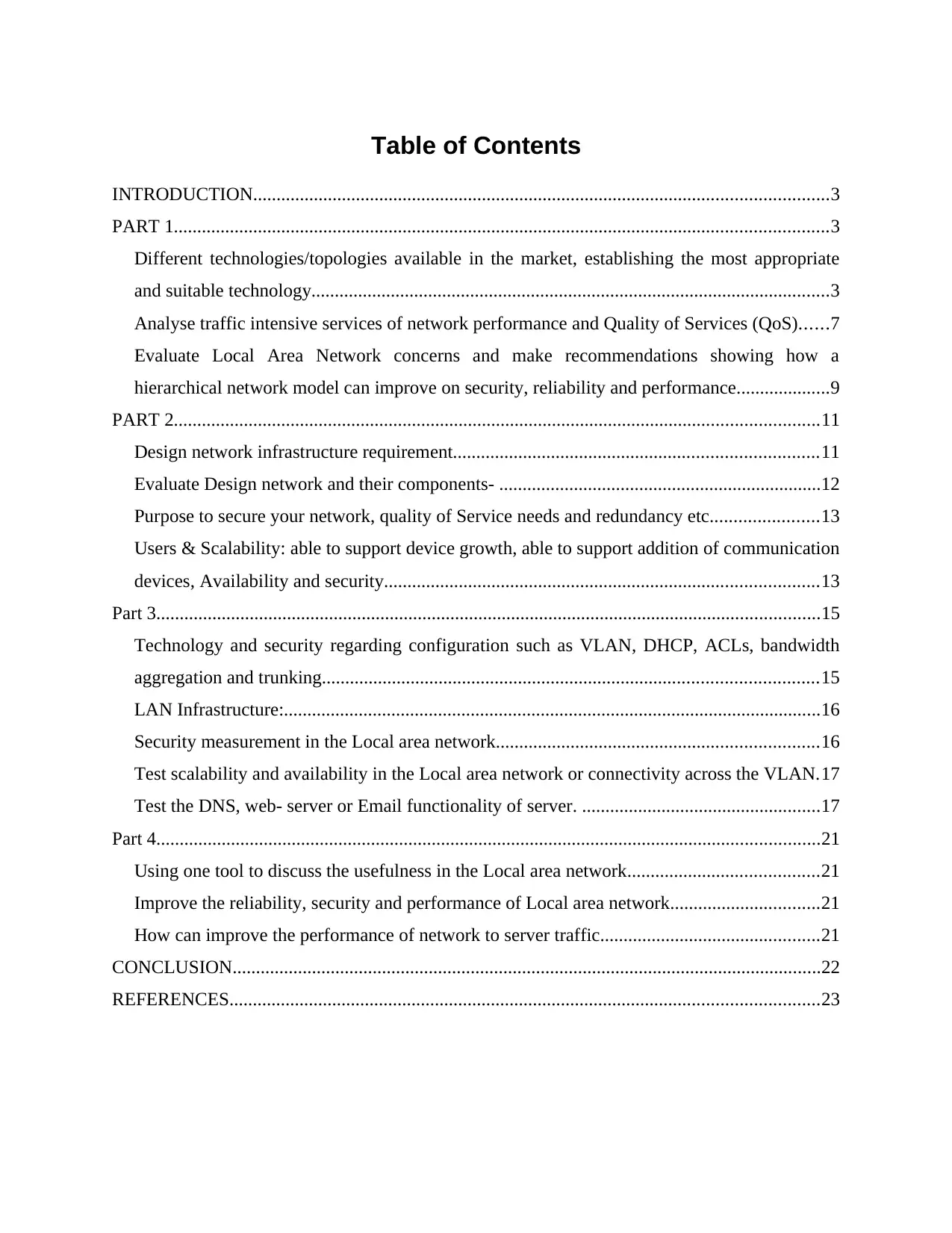
Table of Contents
INTRODUCTION...........................................................................................................................3
PART 1............................................................................................................................................3
Different technologies/topologies available in the market, establishing the most appropriate
and suitable technology...............................................................................................................3
Analyse traffic intensive services of network performance and Quality of Services (QoS)......7
Evaluate Local Area Network concerns and make recommendations showing how a
hierarchical network model can improve on security, reliability and performance....................9
PART 2..........................................................................................................................................11
Design network infrastructure requirement..............................................................................11
Evaluate Design network and their components- .....................................................................12
Purpose to secure your network, quality of Service needs and redundancy etc.......................13
Users & Scalability: able to support device growth, able to support addition of communication
devices, Availability and security.............................................................................................13
Part 3..............................................................................................................................................15
Technology and security regarding configuration such as VLAN, DHCP, ACLs, bandwidth
aggregation and trunking..........................................................................................................15
LAN Infrastructure:...................................................................................................................16
Security measurement in the Local area network.....................................................................16
Test scalability and availability in the Local area network or connectivity across the VLAN.17
Test the DNS, web- server or Email functionality of server. ...................................................17
Part 4..............................................................................................................................................21
Using one tool to discuss the usefulness in the Local area network.........................................21
Improve the reliability, security and performance of Local area network................................21
How can improve the performance of network to server traffic...............................................21
CONCLUSION..............................................................................................................................22
REFERENCES..............................................................................................................................23
INTRODUCTION...........................................................................................................................3
PART 1............................................................................................................................................3
Different technologies/topologies available in the market, establishing the most appropriate
and suitable technology...............................................................................................................3
Analyse traffic intensive services of network performance and Quality of Services (QoS)......7
Evaluate Local Area Network concerns and make recommendations showing how a
hierarchical network model can improve on security, reliability and performance....................9
PART 2..........................................................................................................................................11
Design network infrastructure requirement..............................................................................11
Evaluate Design network and their components- .....................................................................12
Purpose to secure your network, quality of Service needs and redundancy etc.......................13
Users & Scalability: able to support device growth, able to support addition of communication
devices, Availability and security.............................................................................................13
Part 3..............................................................................................................................................15
Technology and security regarding configuration such as VLAN, DHCP, ACLs, bandwidth
aggregation and trunking..........................................................................................................15
LAN Infrastructure:...................................................................................................................16
Security measurement in the Local area network.....................................................................16
Test scalability and availability in the Local area network or connectivity across the VLAN.17
Test the DNS, web- server or Email functionality of server. ...................................................17
Part 4..............................................................................................................................................21
Using one tool to discuss the usefulness in the Local area network.........................................21
Improve the reliability, security and performance of Local area network................................21
How can improve the performance of network to server traffic...............................................21
CONCLUSION..............................................................................................................................22
REFERENCES..............................................................................................................................23
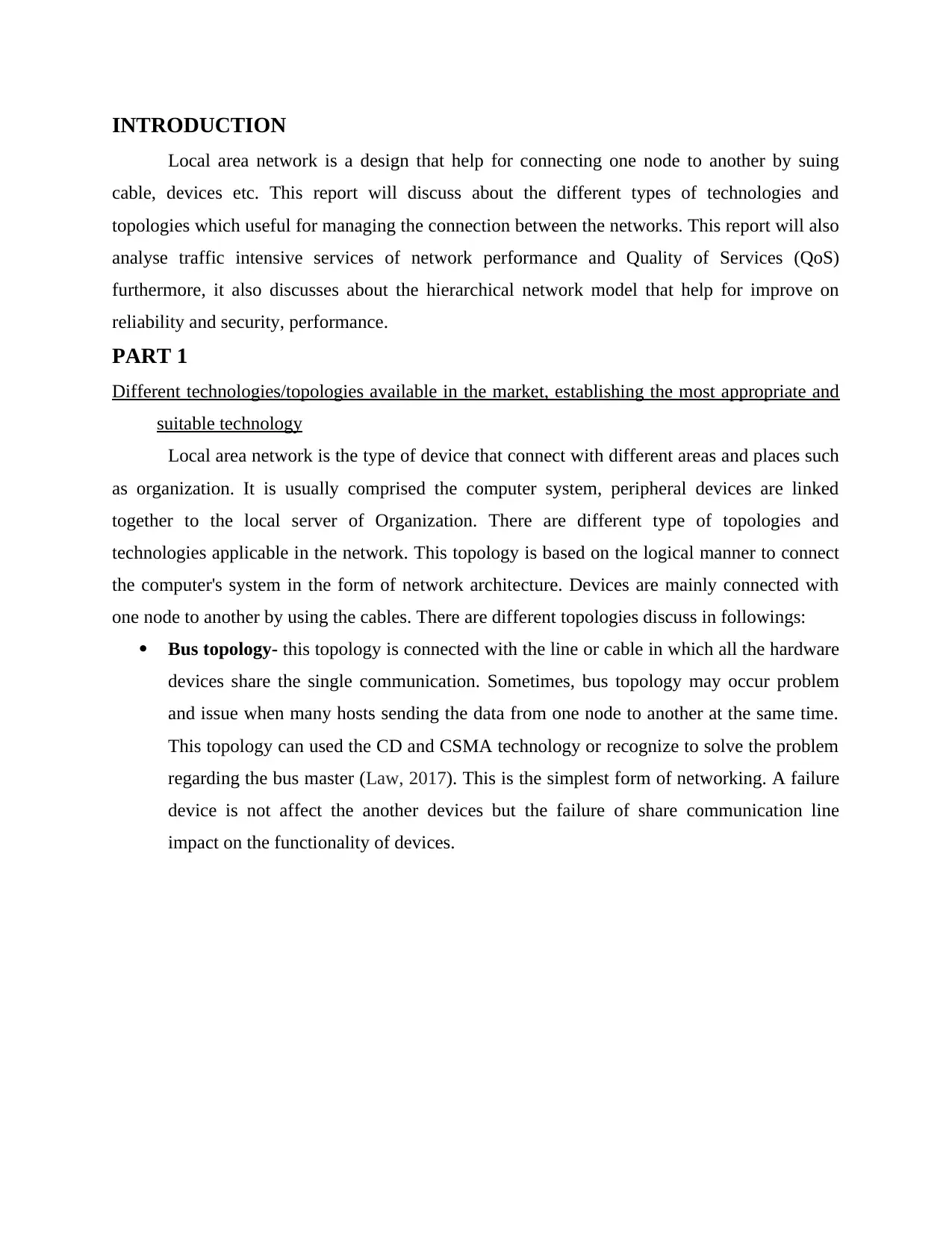
INTRODUCTION
Local area network is a design that help for connecting one node to another by suing
cable, devices etc. This report will discuss about the different types of technologies and
topologies which useful for managing the connection between the networks. This report will also
analyse traffic intensive services of network performance and Quality of Services (QoS)
furthermore, it also discusses about the hierarchical network model that help for improve on
reliability and security, performance.
PART 1
Different technologies/topologies available in the market, establishing the most appropriate and
suitable technology
Local area network is the type of device that connect with different areas and places such
as organization. It is usually comprised the computer system, peripheral devices are linked
together to the local server of Organization. There are different type of topologies and
technologies applicable in the network. This topology is based on the logical manner to connect
the computer's system in the form of network architecture. Devices are mainly connected with
one node to another by using the cables. There are different topologies discuss in followings:
Bus topology- this topology is connected with the line or cable in which all the hardware
devices share the single communication. Sometimes, bus topology may occur problem
and issue when many hosts sending the data from one node to another at the same time.
This topology can used the CD and CSMA technology or recognize to solve the problem
regarding the bus master (Law, 2017). This is the simplest form of networking. A failure
device is not affect the another devices but the failure of share communication line
impact on the functionality of devices.
Local area network is a design that help for connecting one node to another by suing
cable, devices etc. This report will discuss about the different types of technologies and
topologies which useful for managing the connection between the networks. This report will also
analyse traffic intensive services of network performance and Quality of Services (QoS)
furthermore, it also discusses about the hierarchical network model that help for improve on
reliability and security, performance.
PART 1
Different technologies/topologies available in the market, establishing the most appropriate and
suitable technology
Local area network is the type of device that connect with different areas and places such
as organization. It is usually comprised the computer system, peripheral devices are linked
together to the local server of Organization. There are different type of topologies and
technologies applicable in the network. This topology is based on the logical manner to connect
the computer's system in the form of network architecture. Devices are mainly connected with
one node to another by using the cables. There are different topologies discuss in followings:
Bus topology- this topology is connected with the line or cable in which all the hardware
devices share the single communication. Sometimes, bus topology may occur problem
and issue when many hosts sending the data from one node to another at the same time.
This topology can used the CD and CSMA technology or recognize to solve the problem
regarding the bus master (Law, 2017). This is the simplest form of networking. A failure
device is not affect the another devices but the failure of share communication line
impact on the functionality of devices.
⊘ This is a preview!⊘
Do you want full access?
Subscribe today to unlock all pages.

Trusted by 1+ million students worldwide
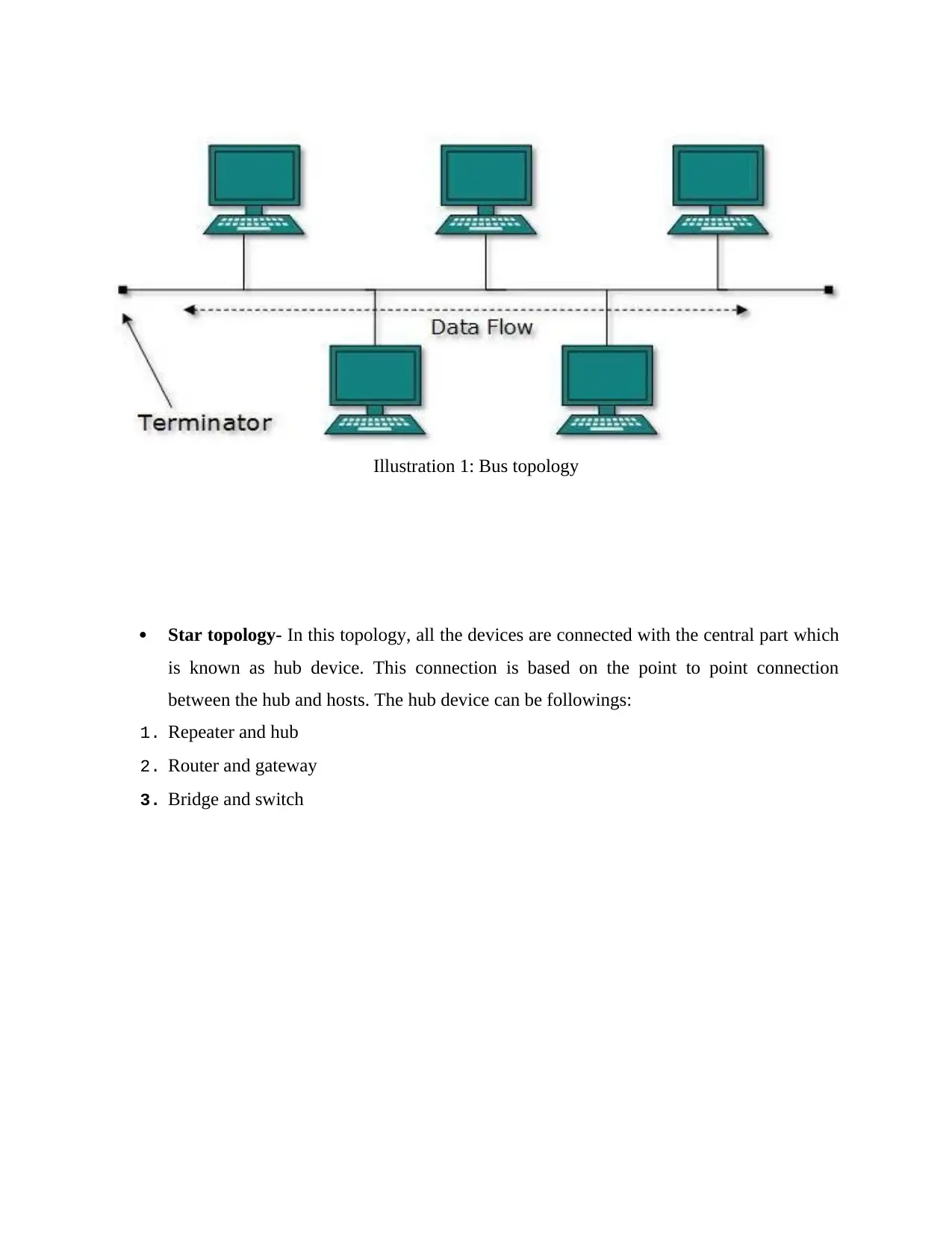
Star topology- In this topology, all the devices are connected with the central part which
is known as hub device. This connection is based on the point to point connection
between the hub and hosts. The hub device can be followings:
1. Repeater and hub
2. Router and gateway
3. Bridge and switch
Illustration 1: Bus topology
is known as hub device. This connection is based on the point to point connection
between the hub and hosts. The hub device can be followings:
1. Repeater and hub
2. Router and gateway
3. Bridge and switch
Illustration 1: Bus topology
Paraphrase This Document
Need a fresh take? Get an instant paraphrase of this document with our AI Paraphraser
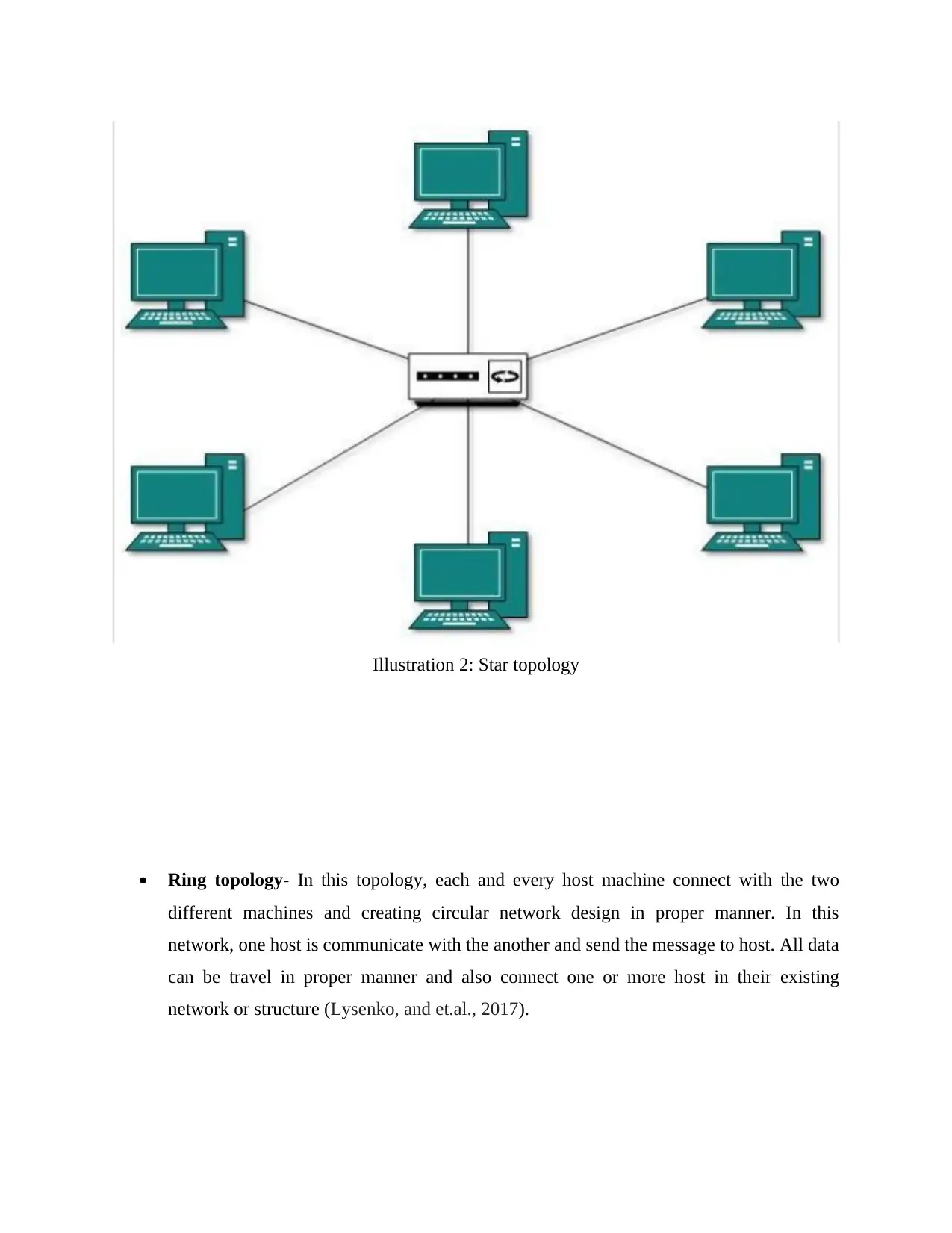
Ring topology- In this topology, each and every host machine connect with the two
different machines and creating circular network design in proper manner. In this
network, one host is communicate with the another and send the message to host. All data
can be travel in proper manner and also connect one or more host in their existing
network or structure (Lysenko, and et.al., 2017).
Illustration 2: Star topology
different machines and creating circular network design in proper manner. In this
network, one host is communicate with the another and send the message to host. All data
can be travel in proper manner and also connect one or more host in their existing
network or structure (Lysenko, and et.al., 2017).
Illustration 2: Star topology
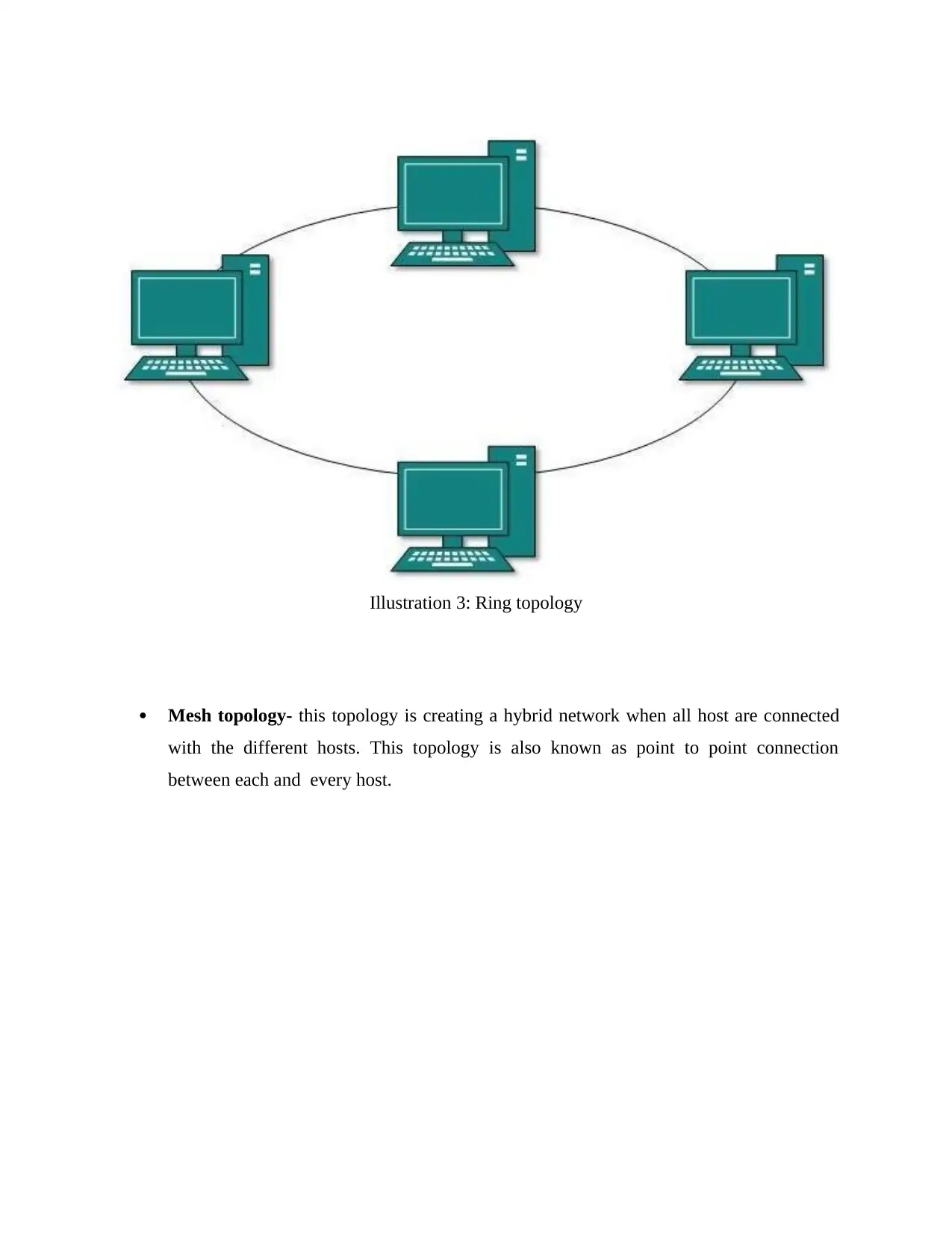
Mesh topology- this topology is creating a hybrid network when all host are connected
with the different hosts. This topology is also known as point to point connection
between each and every host.
Illustration 3: Ring topology
with the different hosts. This topology is also known as point to point connection
between each and every host.
Illustration 3: Ring topology
⊘ This is a preview!⊘
Do you want full access?
Subscribe today to unlock all pages.

Trusted by 1+ million students worldwide
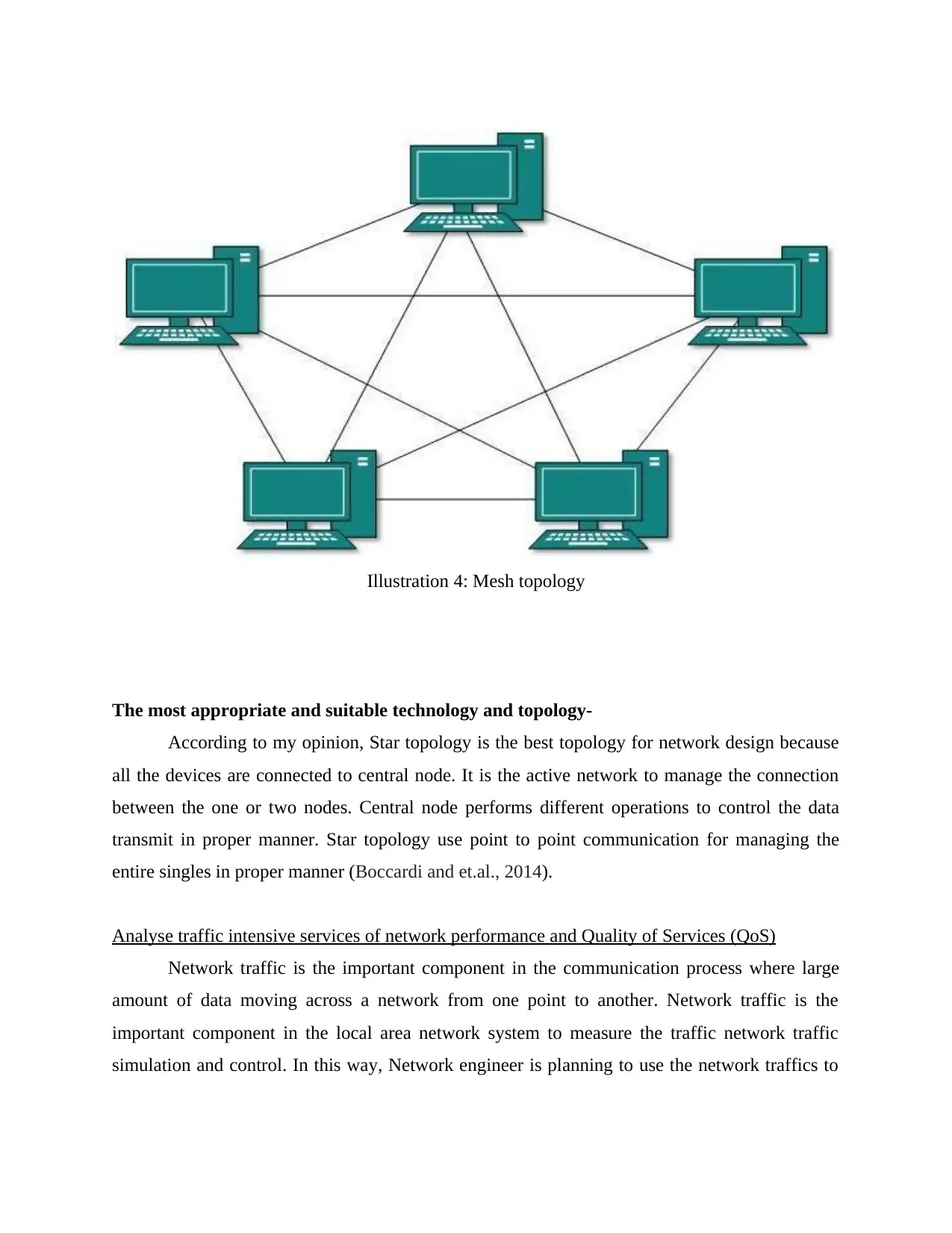
The most appropriate and suitable technology and topology-
According to my opinion, Star topology is the best topology for network design because
all the devices are connected to central node. It is the active network to manage the connection
between the one or two nodes. Central node performs different operations to control the data
transmit in proper manner. Star topology use point to point communication for managing the
entire singles in proper manner (Boccardi and et.al., 2014).
Analyse traffic intensive services of network performance and Quality of Services (QoS)
Network traffic is the important component in the communication process where large
amount of data moving across a network from one point to another. Network traffic is the
important component in the local area network system to measure the traffic network traffic
simulation and control. In this way, Network engineer is planning to use the network traffics to
Illustration 4: Mesh topology
According to my opinion, Star topology is the best topology for network design because
all the devices are connected to central node. It is the active network to manage the connection
between the one or two nodes. Central node performs different operations to control the data
transmit in proper manner. Star topology use point to point communication for managing the
entire singles in proper manner (Boccardi and et.al., 2014).
Analyse traffic intensive services of network performance and Quality of Services (QoS)
Network traffic is the important component in the communication process where large
amount of data moving across a network from one point to another. Network traffic is the
important component in the local area network system to measure the traffic network traffic
simulation and control. In this way, Network engineer is planning to use the network traffics to
Illustration 4: Mesh topology
Paraphrase This Document
Need a fresh take? Get an instant paraphrase of this document with our AI Paraphraser
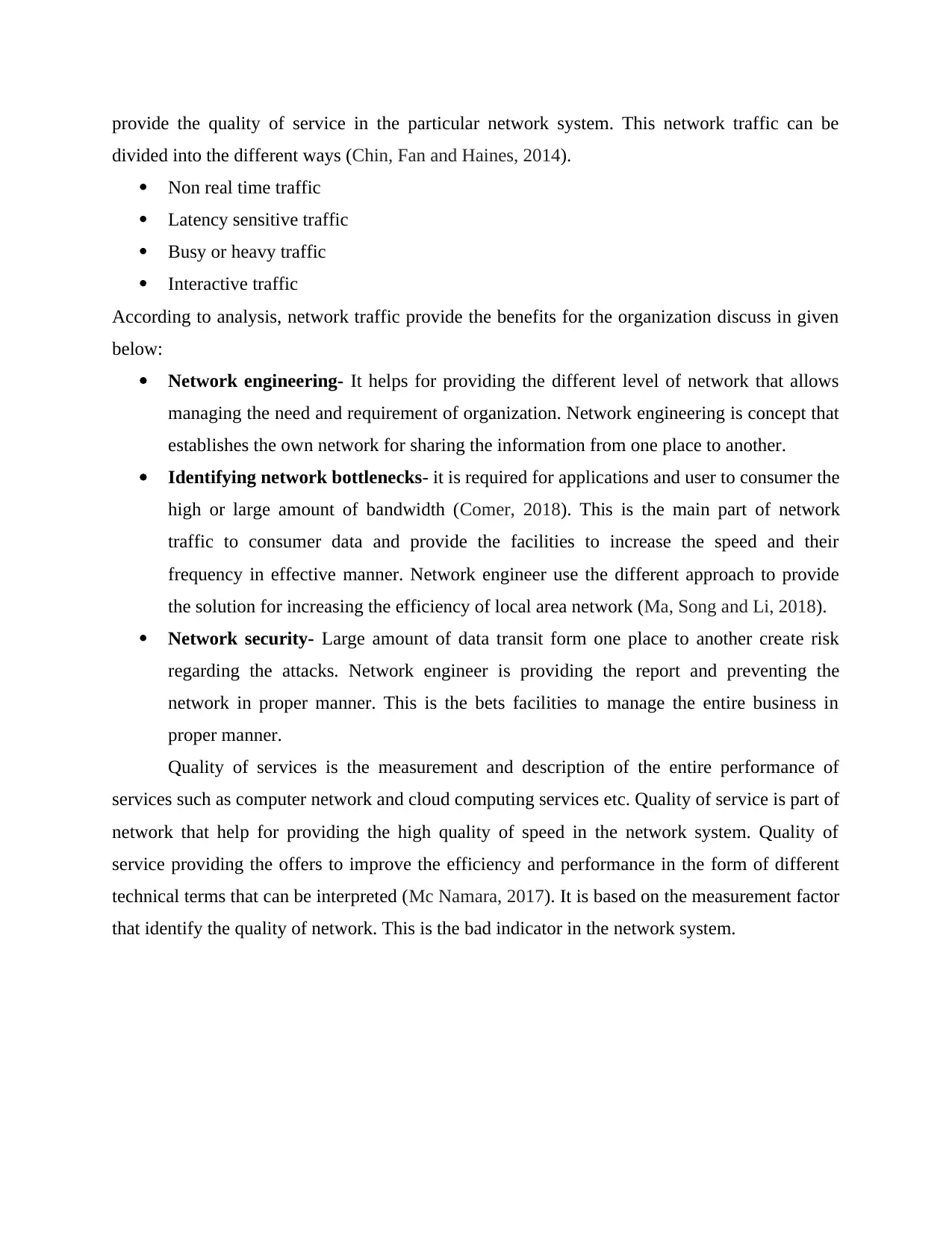
provide the quality of service in the particular network system. This network traffic can be
divided into the different ways (Chin, Fan and Haines, 2014).
Non real time traffic
Latency sensitive traffic
Busy or heavy traffic
Interactive traffic
According to analysis, network traffic provide the benefits for the organization discuss in given
below:
Network engineering- It helps for providing the different level of network that allows
managing the need and requirement of organization. Network engineering is concept that
establishes the own network for sharing the information from one place to another.
Identifying network bottlenecks- it is required for applications and user to consumer the
high or large amount of bandwidth (Comer, 2018). This is the main part of network
traffic to consumer data and provide the facilities to increase the speed and their
frequency in effective manner. Network engineer use the different approach to provide
the solution for increasing the efficiency of local area network (Ma, Song and Li, 2018).
Network security- Large amount of data transit form one place to another create risk
regarding the attacks. Network engineer is providing the report and preventing the
network in proper manner. This is the bets facilities to manage the entire business in
proper manner.
Quality of services is the measurement and description of the entire performance of
services such as computer network and cloud computing services etc. Quality of service is part of
network that help for providing the high quality of speed in the network system. Quality of
service providing the offers to improve the efficiency and performance in the form of different
technical terms that can be interpreted (Mc Namara, 2017). It is based on the measurement factor
that identify the quality of network. This is the bad indicator in the network system.
divided into the different ways (Chin, Fan and Haines, 2014).
Non real time traffic
Latency sensitive traffic
Busy or heavy traffic
Interactive traffic
According to analysis, network traffic provide the benefits for the organization discuss in given
below:
Network engineering- It helps for providing the different level of network that allows
managing the need and requirement of organization. Network engineering is concept that
establishes the own network for sharing the information from one place to another.
Identifying network bottlenecks- it is required for applications and user to consumer the
high or large amount of bandwidth (Comer, 2018). This is the main part of network
traffic to consumer data and provide the facilities to increase the speed and their
frequency in effective manner. Network engineer use the different approach to provide
the solution for increasing the efficiency of local area network (Ma, Song and Li, 2018).
Network security- Large amount of data transit form one place to another create risk
regarding the attacks. Network engineer is providing the report and preventing the
network in proper manner. This is the bets facilities to manage the entire business in
proper manner.
Quality of services is the measurement and description of the entire performance of
services such as computer network and cloud computing services etc. Quality of service is part of
network that help for providing the high quality of speed in the network system. Quality of
service providing the offers to improve the efficiency and performance in the form of different
technical terms that can be interpreted (Mc Namara, 2017). It is based on the measurement factor
that identify the quality of network. This is the bad indicator in the network system.
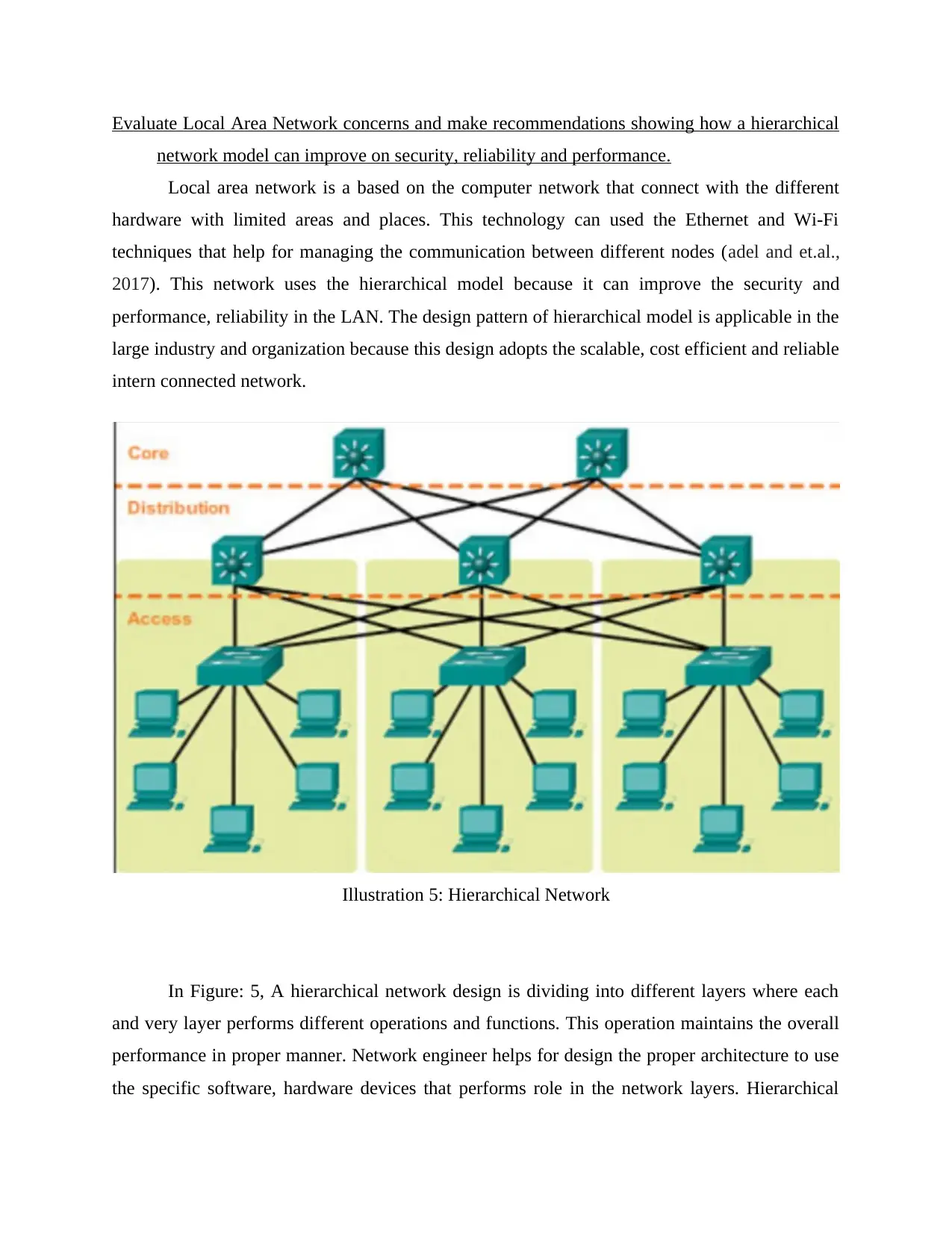
Evaluate Local Area Network concerns and make recommendations showing how a hierarchical
network model can improve on security, reliability and performance.
Local area network is a based on the computer network that connect with the different
hardware with limited areas and places. This technology can used the Ethernet and Wi-Fi
techniques that help for managing the communication between different nodes (adel and et.al.,
2017). This network uses the hierarchical model because it can improve the security and
performance, reliability in the LAN. The design pattern of hierarchical model is applicable in the
large industry and organization because this design adopts the scalable, cost efficient and reliable
intern connected network.
In Figure: 5, A hierarchical network design is dividing into different layers where each
and very layer performs different operations and functions. This operation maintains the overall
performance in proper manner. Network engineer helps for design the proper architecture to use
the specific software, hardware devices that performs role in the network layers. Hierarchical
Illustration 5: Hierarchical Network
network model can improve on security, reliability and performance.
Local area network is a based on the computer network that connect with the different
hardware with limited areas and places. This technology can used the Ethernet and Wi-Fi
techniques that help for managing the communication between different nodes (adel and et.al.,
2017). This network uses the hierarchical model because it can improve the security and
performance, reliability in the LAN. The design pattern of hierarchical model is applicable in the
large industry and organization because this design adopts the scalable, cost efficient and reliable
intern connected network.
In Figure: 5, A hierarchical network design is dividing into different layers where each
and very layer performs different operations and functions. This operation maintains the overall
performance in proper manner. Network engineer helps for design the proper architecture to use
the specific software, hardware devices that performs role in the network layers. Hierarchical
Illustration 5: Hierarchical Network
⊘ This is a preview!⊘
Do you want full access?
Subscribe today to unlock all pages.

Trusted by 1+ million students worldwide
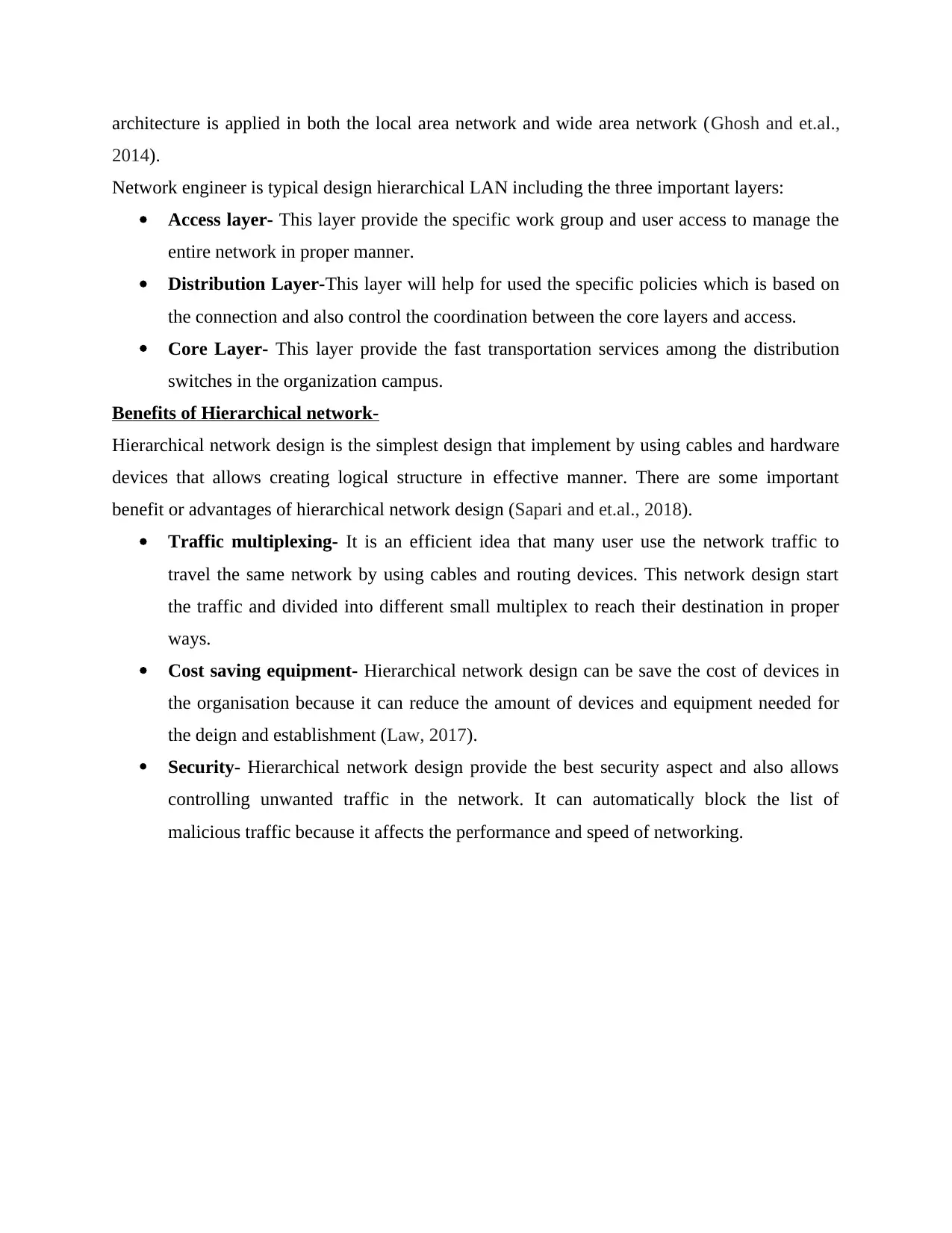
architecture is applied in both the local area network and wide area network (Ghosh and et.al.,
2014).
Network engineer is typical design hierarchical LAN including the three important layers:
Access layer- This layer provide the specific work group and user access to manage the
entire network in proper manner.
Distribution Layer-This layer will help for used the specific policies which is based on
the connection and also control the coordination between the core layers and access.
Core Layer- This layer provide the fast transportation services among the distribution
switches in the organization campus.
Benefits of Hierarchical network-
Hierarchical network design is the simplest design that implement by using cables and hardware
devices that allows creating logical structure in effective manner. There are some important
benefit or advantages of hierarchical network design (Sapari and et.al., 2018).
Traffic multiplexing- It is an efficient idea that many user use the network traffic to
travel the same network by using cables and routing devices. This network design start
the traffic and divided into different small multiplex to reach their destination in proper
ways.
Cost saving equipment- Hierarchical network design can be save the cost of devices in
the organisation because it can reduce the amount of devices and equipment needed for
the deign and establishment (Law, 2017).
Security- Hierarchical network design provide the best security aspect and also allows
controlling unwanted traffic in the network. It can automatically block the list of
malicious traffic because it affects the performance and speed of networking.
2014).
Network engineer is typical design hierarchical LAN including the three important layers:
Access layer- This layer provide the specific work group and user access to manage the
entire network in proper manner.
Distribution Layer-This layer will help for used the specific policies which is based on
the connection and also control the coordination between the core layers and access.
Core Layer- This layer provide the fast transportation services among the distribution
switches in the organization campus.
Benefits of Hierarchical network-
Hierarchical network design is the simplest design that implement by using cables and hardware
devices that allows creating logical structure in effective manner. There are some important
benefit or advantages of hierarchical network design (Sapari and et.al., 2018).
Traffic multiplexing- It is an efficient idea that many user use the network traffic to
travel the same network by using cables and routing devices. This network design start
the traffic and divided into different small multiplex to reach their destination in proper
ways.
Cost saving equipment- Hierarchical network design can be save the cost of devices in
the organisation because it can reduce the amount of devices and equipment needed for
the deign and establishment (Law, 2017).
Security- Hierarchical network design provide the best security aspect and also allows
controlling unwanted traffic in the network. It can automatically block the list of
malicious traffic because it affects the performance and speed of networking.
Paraphrase This Document
Need a fresh take? Get an instant paraphrase of this document with our AI Paraphraser
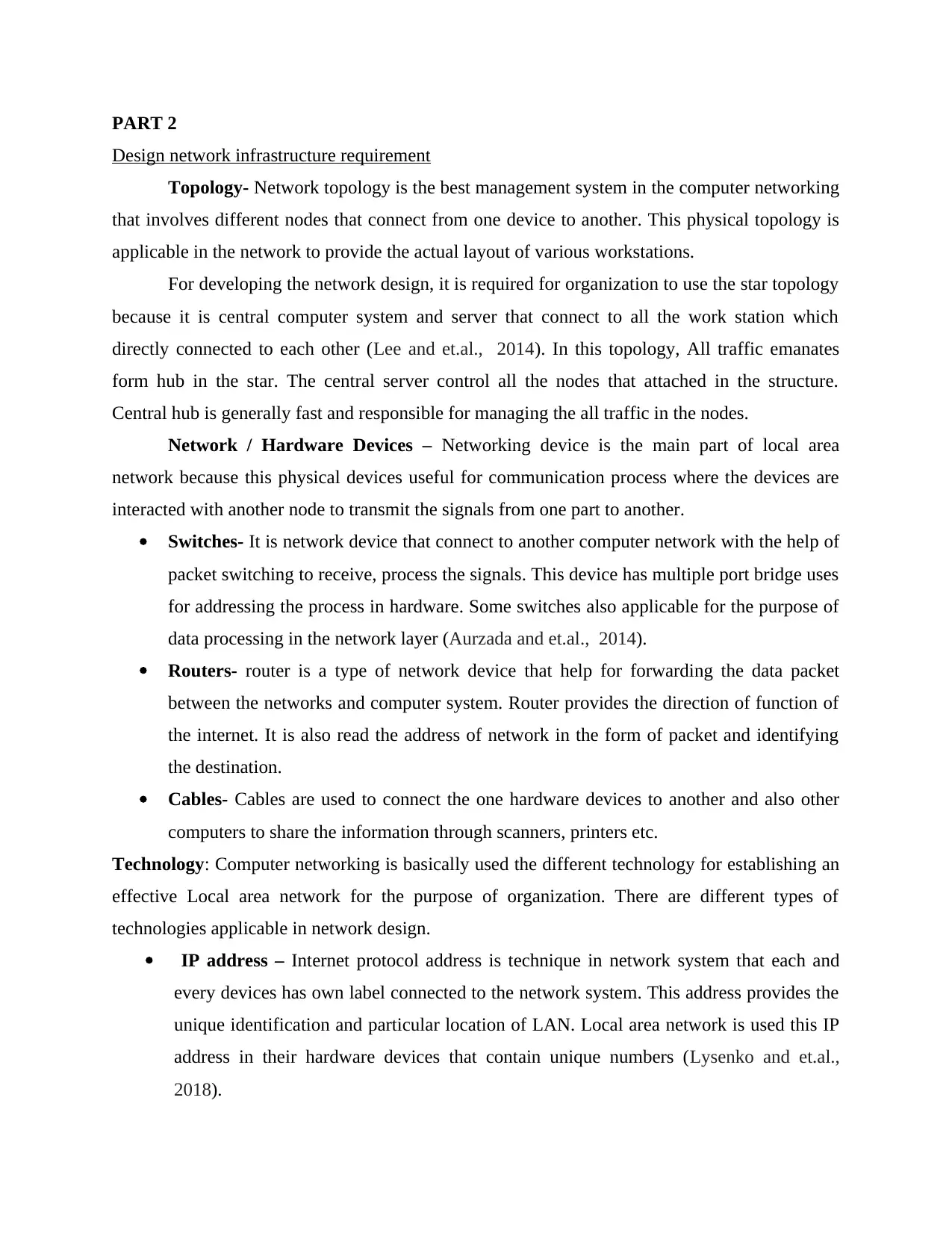
PART 2
Design network infrastructure requirement
Topology- Network topology is the best management system in the computer networking
that involves different nodes that connect from one device to another. This physical topology is
applicable in the network to provide the actual layout of various workstations.
For developing the network design, it is required for organization to use the star topology
because it is central computer system and server that connect to all the work station which
directly connected to each other (Lee and et.al., 2014). In this topology, All traffic emanates
form hub in the star. The central server control all the nodes that attached in the structure.
Central hub is generally fast and responsible for managing the all traffic in the nodes.
Network / Hardware Devices – Networking device is the main part of local area
network because this physical devices useful for communication process where the devices are
interacted with another node to transmit the signals from one part to another.
Switches- It is network device that connect to another computer network with the help of
packet switching to receive, process the signals. This device has multiple port bridge uses
for addressing the process in hardware. Some switches also applicable for the purpose of
data processing in the network layer (Aurzada and et.al., 2014).
Routers- router is a type of network device that help for forwarding the data packet
between the networks and computer system. Router provides the direction of function of
the internet. It is also read the address of network in the form of packet and identifying
the destination.
Cables- Cables are used to connect the one hardware devices to another and also other
computers to share the information through scanners, printers etc.
Technology: Computer networking is basically used the different technology for establishing an
effective Local area network for the purpose of organization. There are different types of
technologies applicable in network design.
IP address – Internet protocol address is technique in network system that each and
every devices has own label connected to the network system. This address provides the
unique identification and particular location of LAN. Local area network is used this IP
address in their hardware devices that contain unique numbers (Lysenko and et.al.,
2018).
Design network infrastructure requirement
Topology- Network topology is the best management system in the computer networking
that involves different nodes that connect from one device to another. This physical topology is
applicable in the network to provide the actual layout of various workstations.
For developing the network design, it is required for organization to use the star topology
because it is central computer system and server that connect to all the work station which
directly connected to each other (Lee and et.al., 2014). In this topology, All traffic emanates
form hub in the star. The central server control all the nodes that attached in the structure.
Central hub is generally fast and responsible for managing the all traffic in the nodes.
Network / Hardware Devices – Networking device is the main part of local area
network because this physical devices useful for communication process where the devices are
interacted with another node to transmit the signals from one part to another.
Switches- It is network device that connect to another computer network with the help of
packet switching to receive, process the signals. This device has multiple port bridge uses
for addressing the process in hardware. Some switches also applicable for the purpose of
data processing in the network layer (Aurzada and et.al., 2014).
Routers- router is a type of network device that help for forwarding the data packet
between the networks and computer system. Router provides the direction of function of
the internet. It is also read the address of network in the form of packet and identifying
the destination.
Cables- Cables are used to connect the one hardware devices to another and also other
computers to share the information through scanners, printers etc.
Technology: Computer networking is basically used the different technology for establishing an
effective Local area network for the purpose of organization. There are different types of
technologies applicable in network design.
IP address – Internet protocol address is technique in network system that each and
every devices has own label connected to the network system. This address provides the
unique identification and particular location of LAN. Local area network is used this IP
address in their hardware devices that contain unique numbers (Lysenko and et.al.,
2018).
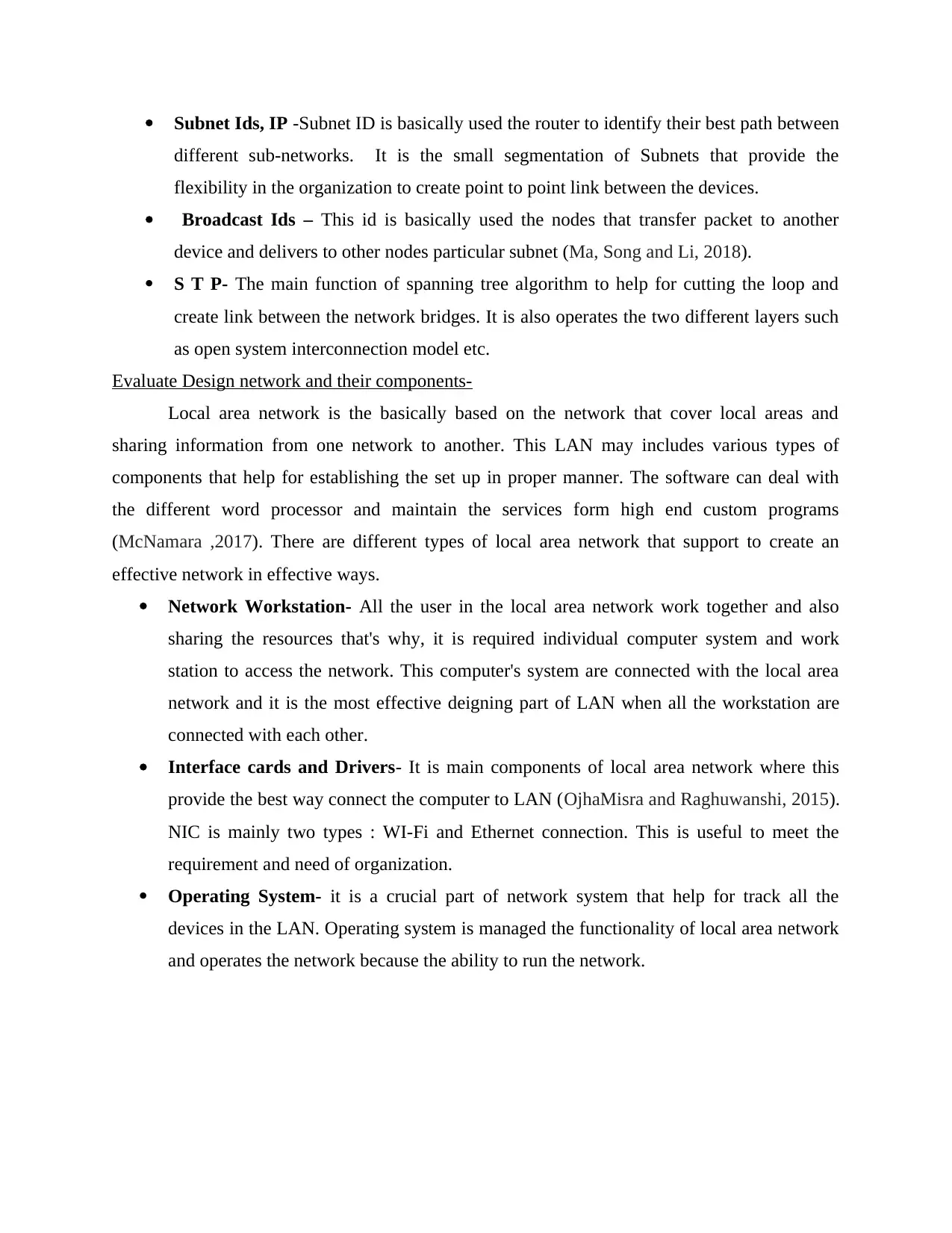
Subnet Ids, IP -Subnet ID is basically used the router to identify their best path between
different sub-networks. It is the small segmentation of Subnets that provide the
flexibility in the organization to create point to point link between the devices.
Broadcast Ids – This id is basically used the nodes that transfer packet to another
device and delivers to other nodes particular subnet (Ma, Song and Li, 2018).
S T P- The main function of spanning tree algorithm to help for cutting the loop and
create link between the network bridges. It is also operates the two different layers such
as open system interconnection model etc.
Evaluate Design network and their components-
Local area network is the basically based on the network that cover local areas and
sharing information from one network to another. This LAN may includes various types of
components that help for establishing the set up in proper manner. The software can deal with
the different word processor and maintain the services form high end custom programs
(McNamara ,2017). There are different types of local area network that support to create an
effective network in effective ways.
Network Workstation- All the user in the local area network work together and also
sharing the resources that's why, it is required individual computer system and work
station to access the network. This computer's system are connected with the local area
network and it is the most effective deigning part of LAN when all the workstation are
connected with each other.
Interface cards and Drivers- It is main components of local area network where this
provide the best way connect the computer to LAN (OjhaMisra and Raghuwanshi, 2015).
NIC is mainly two types : WI-Fi and Ethernet connection. This is useful to meet the
requirement and need of organization.
Operating System- it is a crucial part of network system that help for track all the
devices in the LAN. Operating system is managed the functionality of local area network
and operates the network because the ability to run the network.
different sub-networks. It is the small segmentation of Subnets that provide the
flexibility in the organization to create point to point link between the devices.
Broadcast Ids – This id is basically used the nodes that transfer packet to another
device and delivers to other nodes particular subnet (Ma, Song and Li, 2018).
S T P- The main function of spanning tree algorithm to help for cutting the loop and
create link between the network bridges. It is also operates the two different layers such
as open system interconnection model etc.
Evaluate Design network and their components-
Local area network is the basically based on the network that cover local areas and
sharing information from one network to another. This LAN may includes various types of
components that help for establishing the set up in proper manner. The software can deal with
the different word processor and maintain the services form high end custom programs
(McNamara ,2017). There are different types of local area network that support to create an
effective network in effective ways.
Network Workstation- All the user in the local area network work together and also
sharing the resources that's why, it is required individual computer system and work
station to access the network. This computer's system are connected with the local area
network and it is the most effective deigning part of LAN when all the workstation are
connected with each other.
Interface cards and Drivers- It is main components of local area network where this
provide the best way connect the computer to LAN (OjhaMisra and Raghuwanshi, 2015).
NIC is mainly two types : WI-Fi and Ethernet connection. This is useful to meet the
requirement and need of organization.
Operating System- it is a crucial part of network system that help for track all the
devices in the LAN. Operating system is managed the functionality of local area network
and operates the network because the ability to run the network.
⊘ This is a preview!⊘
Do you want full access?
Subscribe today to unlock all pages.

Trusted by 1+ million students worldwide
1 out of 29
Related Documents
Your All-in-One AI-Powered Toolkit for Academic Success.
+13062052269
info@desklib.com
Available 24*7 on WhatsApp / Email
![[object Object]](/_next/static/media/star-bottom.7253800d.svg)
Unlock your academic potential
Copyright © 2020–2025 A2Z Services. All Rights Reserved. Developed and managed by ZUCOL.





